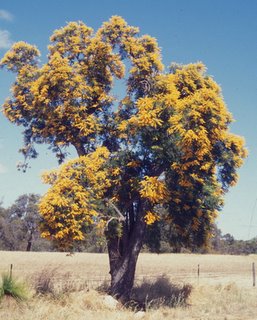 Mistletoes are parasitic or semi-parasitic plants that grow on the branches of trees. They are unlike the bird's-nest (Asplenium nidus) and staghorn (Platycerium coronarium) ferns that depend on the trees mainly for support. These epiphytes do not demand anything else from the host, neither water nor nutrients. Mistletoes on the other hand are very different from epiphytes. These are parasitic plants that draw water and nutrients from the host, to eventually stunt or even kill the host plant.
Mistletoes are parasitic or semi-parasitic plants that grow on the branches of trees. They are unlike the bird's-nest (Asplenium nidus) and staghorn (Platycerium coronarium) ferns that depend on the trees mainly for support. These epiphytes do not demand anything else from the host, neither water nor nutrients. Mistletoes on the other hand are very different from epiphytes. These are parasitic plants that draw water and nutrients from the host, to eventually stunt or even kill the host plant. In Singapore there used to be two main genera of mistletoes, Loranthus and Viscum. Then Loranthus was split into six genera, but not Viscum. All these mistletoes (except one species of Viscum) have green leaves, meaning that they are able to photosynthesise and manufacture their own food. Thus they are termed semi-parasitic.
Mistletoes are important bird plants. Their flowers produce copious nectar that attract a host of butterflies. And also birds like sunbirds and flowerpeckers. Their succulent berries similarly attract many species of birds.
 Incidentally, the Australian Christmas tree (Nuytsia floribunda) is a member of this family of plants. It is the largest mistletoe in the world, growing independently into a 8 metre tall tree. If you visit Western Australia during December and January, you can marvel at the glorious, honey-scented, orange-gold blossoms covering the entire tree, even hiding the fleshy foliage. This tree manages to grow and flower during the dry Australian summer because its roots tap onto the roots of other neighbouring plants for water. The trunk exudes a sweet, sticky gum and the young roots are peeled and eaten, tasting like sugar-candy.
Incidentally, the Australian Christmas tree (Nuytsia floribunda) is a member of this family of plants. It is the largest mistletoe in the world, growing independently into a 8 metre tall tree. If you visit Western Australia during December and January, you can marvel at the glorious, honey-scented, orange-gold blossoms covering the entire tree, even hiding the fleshy foliage. This tree manages to grow and flower during the dry Australian summer because its roots tap onto the roots of other neighbouring plants for water. The trunk exudes a sweet, sticky gum and the young roots are peeled and eaten, tasting like sugar-candy.
two examples might not be a trend but I have seen mistletoes on two separate Bauhinia or Coral trees.
ReplyDeleteI wonder what bird it is that frequents these trees to 'plant' the mistletoe.
The mistletoe birds are sunbirds and flowerpeckers mainly. Subsequent postings of this series will deal in detail the fauna and how the seeds are deposited on the branches of the host plants. As they say, stay tuned...
ReplyDelete